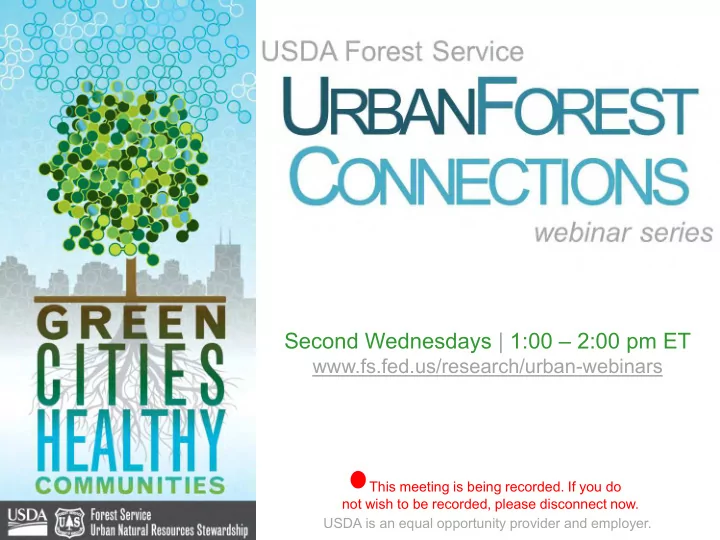

Second Wednesdays | 1:00 – 2:00 pm ET www.fs.fed.us/research/urban-webinars This meeting is being recorded. If you do not wish to be recorded, please disconnect now. USDA is an equal opportunity provider and employer.
R ESTORING U RBAN E COSYSTEMS WITH T REES : C LEANING AND GREENING Ronald S. Zalesny Jr. Richard A. Hallett Research Plant Geneticist Research Ecologist Northern Research Station Northern Research Station USDA Forest Service USDA Forest Service
Restoring Urban Ecosystems with Trees: Cleaning and Greening R.S. Zalesny Jr. 1 , R.A. Hallett 2 U.S. Forest Service Northern Research Station 1 Institute for Applied Ecosystem Studies Rhinelander, WI, USA 2 Center for Research on Ecosystem Change New York City Urban Field Station Bayside, NY, USA
Phytoremediation Afforestation Restoration Ecology Partnerships Primer Ecosystem Ecosystem Degradation Restoration
Ecosystem Services “The benefits people obtain from ecosystems” (Source: http://www.greenfacts.org/glossary/def/ecosystem-services.htm) Cultural Services The nonmaterial benefits obtained from Millennium Ecosystem Assessment (MEA). 2005. ecosystems (e.g., values) Ecosystems and Human Well-Being: Synthesis. Island Press, Washington. 155pp. Spiritual Educational Supporting Services The natural processes that maintain the other ecosystem services Nitrogen Water Provisioning Services The goods or products obtained from ecosystems Freshwater Biomass Regulating Services The benefits obtained from an ecosystem’s control of natural processes Erosion Control Soil Quality 5
The “Re - ” Continuum Positive Ecosystem Function Need plants that are workhorses (e.g., Plant Biomass) Restoration Continuum between complete ecosystem degradation & pre- Remediation disturbance condition (restoration) for positive Reclamation ecosystem function & species diversity / Rehabilitation complexity. Recovery Ecosystem Degradation Species Diversity/Complexity 6
Phytoremediation Phytovolatilization (organics & inorganics) Phytodegradation (organics) Phytoextraction (inorganics, esp. heavy metals) Rhizofiltration (organics & inorganics) Phytostabilization Rhizodegradation (organics & inorganics) (organics)
Traits of Interest Elevated water usage Fast growth (high productivity) Extensive root systems
Poplars Willows
Rationale 11
Phytoremediation Examples 13 Zalesny RS Jr, et al. 2014. International Poplar Symposium VI; Vancouver, British Columbia, Canada; July 21-23.
LaSalle, IL Industrial Brownfield (TCE, PCE) 11 yrs 19 clones Crandon 7300501 220-5 20.3 cm 26.3 cm 34.5 cm + 19% versus expected diameter in the region 14 Zalesny RS Jr, et al. 2014. International Poplar Symposium VI; Vancouver, British Columbia, Canada; July 21-23.
Elizabeth City, NC US Coast Guard Base Petroleum Hydrocarbons 3 Plantings E1: 6 yrs, 4 clones E2: 5 yrs, 4 clones E3: 5 yrs, 4 clones 15 Zalesny RS Jr, et al. 2014. International Poplar Symposium VI; Vancouver, British Columbia, Canada; July 21-23.
Panama City, FL Industrial Brownfield DBH exp = 8.9 + 102% Arsenic 5.4 yrs 15 Clones Biomass MAIexp = 7.2 + 340% 16 Zalesny RS Jr, et al. 2014. International Poplar Symposium VI; Vancouver, British Columbia, Canada; July 21-23.
The Phyto Matrix Tree Tissue Genus / Genotype Leaf Woody Root Inorganic Contaminant Populus A B C ↓ ↓ ↓ ↓ Salix A B C ↓ ↓ ↓ ↓ 17
Industrial Production Facility Salts, metals, nitrates 11 years
Landfill Salts in leachate 8 years
Landfill Fiber cake recycling 12.5 years
Tree Planting is Strategic! Ecology Buffer Great Lakes (TMDLs) Redirect surface water Increase tree canopy Carbon sequestration Redevelopment Create green space (livability) Urban amenity plantings Direct contact issues Economic value of trees 21
http://www.nrs.fs.fed.us/news/review/19
Afforestation & Reforestation Afforestation The establishment of a forest or stand in an area where the preceding vegetation or land use was not forest Reforestation The reestablishment of forest cover either naturally (by natural seeding, coppice, or root suckers) or artificially (by direct seeding or planting) 25 Helms JA. 1998. The Dictionary of Forestry. Society of American Foresters.
It’s not just semantics. Reforestation? https://www.mannahatta2409.org/
Revisiting the “Re - ” Continuum Positive Ecosystem Function (e.g., Plant Biomass) Restoration Continuum between complete ecosystem degradation & pre- Remediation disturbance condition (restoration) for positive Reclamation ecosystem function & species diversity / Rehabilitation complexity. Recovery Ecosystem Degradation Species Diversity/Complexity 27
by the way….. It needs to be sustainable and resilient.
Kissena Park Afforestation Planted four years ago with 3-5 year old stock.
This one started from a seed. Planted at the same time.
Project Design • 12 urban soils collected from NYC Parks • 4 categories of soil Coal Ash Urban Fill Clean Fill Native Till 31
P < 0.0001 A AB AB AB BC ABC BC BC BC C D D Native Till Coal Ash Clean Fill Urban Fill
Partnerships
Staten Island, New York Urban Afforestation Freshkills Afforestation Project Objectives Utilize poplar & willow as part of a forest succession program to achieve more rapid canopy closure on urban afforestation sites Use phyto-recurrent selection to identify superior genotypes capable of growing under the harsh site conditions Incorporate ozone treatments into phyto-recurrent selection eo.wikipedia.org Enhance the physical, chemical, biological, & agronomic characteristics of the soils Prevent the establishment of invasive plant species Encourage the establishment of native vegetation & invertebrates 36
Phyto-Recurrent Selection for Planned Urban Afforestation Objective 1: Test hormone treatments Cycle 0 Objective 2: Incorporate propagation into PRS Current propagation efforts Objective 3: Establish population of genotypes Cycle 1 Spring 2014 Greenhouse 2 soils, 85 genotypes Testing: 1) early rooting, 2) survival in field soil Cycle 2 Spring 2014 Greenhouse 2 soils, 40 genotypes Testing: 1) early biomass, 2) survival in field soil Native Plants 15:29-41. Cycle 3 Summer 2014 Greenhouse 2 soils, 20 genotypes Testing: 1) biomass, 2) soil effects, 3) soil & plant chemistries Scale-up Winter/Spring 2015 Favorable genotypes Cycle 4 S ummer 2015 Field 15-20 genotypes Testing: 1) field establishment, 2) biomass, 3) soil effects
Project Description Freshkills Afforestation Project Serviceberry Eastern red cedar Pitch pine Eastern white pine Box elder White oak Scrub oak Pin oak Willow oak Experimental Block 38
Thank you! Acknowledgements We thank Margie Ewing Costa for the opportunity to speak today.
Recommend
More recommend